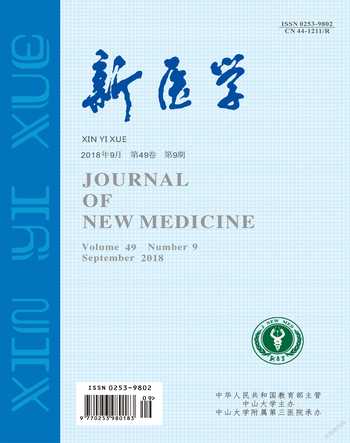七氟醚对老龄血管性认知功能障碍大鼠认知功能的影响及其机制研究
肖高鹏 李俞锦
【摘要】目的探讨七氟醚对老龄血管性认知功能障碍大鼠认知功能的影响及作用机制。方法将60只6月龄雌性Wistar大鼠分为3组,每组各20只。A组大鼠为假手术组,B组大鼠实施右侧颈动脉结扎术;C组大鼠实施右侧颈动脉结扎术后吸入2%七氟醚。采用穿梭箱和水迷宫试验评价大鼠的认知功能,原位末端脱氧核苷酸转移酶标记法检测海马神经元凋亡指数,流式细胞仪检测神经元细胞的凋亡指数和钙离子荧光指数,ELISA检测海马组织和外周血炎性因子[血管内皮生长因子(VEGF)、IL1β、TNFα]水平以及海马神经元细胞匀浆中线粒体呼吸链复合体Ⅰ~Ⅳ的活性。结果 穿梭箱试验中B、C组大鼠的电击次数多于A组、主动逃避次数少于A组、学习和记忆潜伏期较A组延长(P均<001),而C组大鼠电击次数较B组减少、主动逃避次数较B组增多、学习和记忆潜伏期短于C组(P均<001)。B、C组大鼠海马组织及外周血血清VEGF水平低于A组、IL1β和TNFα水平高于A组(P均<005);与B组比较,C组VEGF水平较高、IL1β和TNFα水平较低(P均<005)。大鼠血清VEGF水平与电击次数、学习潜伏期、记忆潜伏期均呈负相关(P均<005),与主动逃避次数呈正相关。IL1β水平和TNFα水平与电击次数、学习潜伏期、记忆潜伏期均呈正相关(P均<005),与主动逃避次数均呈负相关(P均<005)。A、C组大鼠的海馬神经元细胞凋亡指数和钙离子荧光指数均低于B组(P均<001)、海马中线粒体呼吸链复合物Ⅰ、Ⅱ活性高于B组(P均<005),A、C上述指标组间比较差异均无统计学意义(P>005)。结论七氟醚干预可减轻老龄大鼠血管性认知功能障碍,其机制可能与增加VEGF表达、减轻炎症损伤有关。
【关键词】血管性认知功能障碍;七氟醚;炎性因子;血管内皮生长因子
Effect and mechanism of sevoflurane on the cognitive function in elderly rats with vascular cognitive impairmentXiao Gaopeng,Li Yujin Department of Anesthesiology,the First Peoples Hospital of Yunnan Province, Kunming 650000, China
Corresponding author, Li Yujin
【Abstract】ObjectiveTo investigate the effect and mechanism of sevoflurane on the cognitive function in elderly rats with vascular cognitive impairment MethodsSixty male Wistar rats aged 6 months were divided into three groups (n=20 for each group) In group A, sham operation was performed In group B, rats were treated with unilateral carotid artery ligation In group C, unilateral carotid artery ligation was performed, followed by the inhalation of 2% sevoflurane The cognitive function of rats was evaluated by shuttle box and water maze tests The apoptotic index of hippocampal neurons was detected by TUNEL The apoptotic rate and calcium ion fluorescent index of neurons were measured by flow cytometry The expression levels of inflammatory cytokines (VEGF, IL1β and TNFα) in the hippocampal tissues and peripheral blood and the activity of mitochondrial respiratory chain complex IIV in the hippocampal neurons were quantitatively detected by ELISA ResultsDuring the shuttle box test, the number of electrical shocks was significantly more, the number of active escape was considerably less and the learning and memory latency was significantly longer in groups B and C compared with those in group A (all P<001) In group C, the number of electrical shocks was significantly decreased, the number of active escape was considerably increased and the latency of learning and memory was significantly longer than those in group B (all P<001) In groups B and C, the expression levels of VEGF in hippocampal tissues and peripheral blood were significantly lower, whereas the expression levels of IL1β and TNFα were significantly higher than those in group A (both P<005) Compared with group B, the expression level of VEGF was evidently higher, whereas the expression levels of IL1β and TNFα were significantly lower in group C (all P<005) The expression level of serum VEGF was negatively correlated with the number of electrical shocks, learning and memory latency (both P<005), whereas positively associated with the number of active escape The expression levels of IL1β and TNFα were positively correlated with the number of electrical shocks, learning and memory latency (all P<005), whereas negatively correlated with the number of active escape (P<005) In groups A and C, the apoptotic index of hippocampal neurons and calcium ion fluorescent index were significantly lower (both P<001), whereas the activity of mitochondrial respiratory chain complex ⅠandⅡ was considerably higher (both P<005) than those in group B No statistical significance was noted in these parameters between groups A and C (all P>005) Conclusion Sevoflurane intervention can alleviate vascular cognitive impairment in aged rats, which is probably correlated with upregulating the expression of VEGF and mitigating inflammatory injury
【Key words】Vascular cognitive impairment; Sevoflurane; Inflammatory cytokine;
Vascular endothelial growth factor
血管性认知功能障碍是血管或血管相关因素引起的认知功能障碍,与血管性炎症性损伤密切相关,常发生于麻醉和(或)手术后[12]。高龄患者耐受麻醉和手术的能力低,而且随着肝、肾功能的减退,药物在其体内消除的半衰期也延长。七氟醚对心率影响不明显、气道刺激小,为临床常用麻醉药物。有学者认为,七氟醚能激活线粒体中的相关信号通路,减少炎性因子的生成,从而缓解术后脑损伤[3]。然而,4%七氟醚吸入诱导约2 min患者意识即可消失,麻醉过深时有诱发全身痉挛的可能。目前有关七氟醚用于血管性认知功能障碍的效果尚有争议,因此本研究着重探讨七氟醚对老年血管性认知功能障碍大鼠认知功能的影响及其作用机制,现报告如下。
材料与方法
一、实验动物
60只6月龄雌性Wistar大鼠,体质量250~300 g,购自中科院上海实验动物中心,饲养于SPF级动物房,本研究对实验动物的处置均符合中华人民共和国科学技术部颁发的《关于善待实验动物的指导性意见》。
二、主要试剂和仪器
七氟醚购自江苏恩华制药有限公司,血管内皮生长因子(VEGF)、IL1β和TNFα检测试剂盒购自南京碧云天公司,戊巴比妥钠和伊文思蓝购自北京雷根生物公司,原位末端脱氧核苷酸转移酶标记(TUNEL)试剂盒购自北京雷根生物公司;贝克曼库尔特Cyto FLEX流式细胞仪。
三、方法
1实验动物分组
60只大鼠按随机数字表法分为A、B、C组,每组各20只。A组大鼠为假手术组;B组大鼠为血管性认知功能障碍模型,实施右侧颈动脉结扎术,结扎时间为1 h;C组大鼠实施右侧颈动脉结扎术后吸入2%七氟醚(每日2 h,共计5 d)[4]。
2大鼠认知功能检测
穿梭箱试验:成功造模3 d后实施,穿梭箱规格为60 cm×16 cm×25 cm。将大鼠置于穿梭箱中20 s后,开启蜂鸣器,5 s后给予30 V 50 Hz电击,总电击时间为1 min,统计电击和主动逃避的次数。每只实验大鼠重复3次测试,结果取平均值。
水迷宫试验:穿梭箱试验3 d后实施,第1~3日进行定位航行训练,第4日以大鼠寻找并爬上平台的时间为逃避潜伏期;第8日进行空间探索实验,以在原平台Ⅰ象限游泳时间即空间探索时间为记忆潜伏期。
3大鼠海马组织和血清标本取材
水迷宫试验完成后,经大鼠腹腔注射 2%戊巴比妥(50 mg/kg)进行麻醉,取尾静脉血后断头处死,夹闭腹主动脉,灌注4 ℃ 4%多聚甲醛,速度先快后慢,共30 min,至右耳流出液体血色较浅且基本澄清为止,冰上分离脑组织,剥离双侧海马。
4大鼠海马神经元细胞凋亡情况的检测
每組取8只大鼠的海马组织浸入4%的多聚甲醛溶液中,置4 ℃固定24 h,采用TUNEL染色,于显微镜下观察海马神经元细胞的凋亡情况:每张海马切片随机选择5个互相不重叠的视野,并选择400倍荧光显微镜下观察,阳性凋亡细胞的细胞核呈绿色颗粒状,计算凋亡指数,凋亡指数=阳性细胞数/(阳性细胞数+阴性细胞数)×100%。
5海马神经元钙离子水平检测
每组各取6只大鼠的海马组织制作组织匀浆,2 000~3 000转/分离心20 min,收集上清,应用流式细胞仪检测,以荧光指数反映胞浆钙离子水平。
6炎性因子及线粒体呼吸链复合体水平的检测
20只大鼠的尾静脉血加入10% 01 mol/L柠檬酸钠混合10~20 min后,2 000~3 000转/分离心20 min,收集上清,应用ELISA检测大鼠血清中TNFα、IL1β和VEGF水平。每组取6只大鼠的海马组织剪碎后加入DMEM培养基制成单细胞悬液,以ELISA检测海马神经元中TNFα、IL1β、VEGF和线粒体呼吸链复合物Ⅰ~Ⅳ水平。
四、统计学处理
使用SPSS 210处理数据。计量资料均先行正态性检验,符合正态分布者以±s表示,多组比较用方差分析,组间两两比较使用LSDt检验;老龄大鼠血清炎性因子水平与认知功能的关系采用Pearson相关性分析。P<005为差异有统计学意义。
结果
一、3组老龄大鼠的行为学测定结果
1穿梭箱试验结果
B、C组大鼠的电击次数均多于A组,主动逃避次数均少于A组(P均<001);而C组大鼠电击次数较B组减少,主动逃避次数较B组增多(P均<001),见表1。
讨论
炎症反应是缺血性神经元损伤的主要机制,微血管损伤诱发的缺血再灌注损伤的核心是炎症反应的活化,痴呆程度和炎症与脑血管损伤有着直接的联系,所以抑制炎症是治疗脑血管疾病的主要策略。TNFα 与 IL1β是脑缺血损伤炎症反应最早出现的细胞因子[57]。脑室注射IL1β抑制剂可改善大鼠空间学习能力的损害[8]。TNFα水平的上调与认知功能障碍有关[9]。研究发现,麻醉药物能够抑制炎性细胞因子的过度产生,并能减轻由缺血诱发的神经元凋亡[1011]。VEGF能够促进血管的生长和侧支循环的建立,是脑缺血性损伤的血管修复因子。局灶脑缺血的动物实验显示,脑梗死后 3 d是最活跃的血管增生期,并可见明显的VEGF表达,提示应激反应能够诱发VEGF表达的上调,促进神经元功能的恢复[1213]。本研究显示,与缺血、缺氧诱发认知功能障碍的模型大鼠相比,吸入七氟醚的认知功能障碍大鼠海马组织及外周血VEGF水平上升,TNFα和IL1β水平下降,穿梭箱试验中其电击次数较少、主动逃避次数较多,水迷宫试验中其学习和记忆潜伏期较短,提示七氟醚对改善缺血、缺氧诱发的认知功能障碍有一定的效果。
細胞凋亡是多阶段且并非同步发生的进程。急性脑血管病可导致机体产生大量的自由基,并导致细胞内发生钙超载,从而引发神经元细胞凋亡[14]。多项研究显示,神经元缺血、缺氧后自由基明显增多,其能持续开放线粒体的渗透性转换孔,导致线粒体膜电位发生异常、细胞凋亡[15]。研究表明,大鼠的学习和记忆能力下降,与细胞超微结构如线粒体的肿胀和功能障碍密切相关[16]。另有研究显示,强应激会导致海马神经元的树突棘发生退缩乃至消失[17]。七氟醚能够拮抗缺血诱发的海马神经元凋亡及减少神经元的钙超载状态[18]。本研究中,经七氟醚干预的认知功能障碍大鼠海马组织神经元凋亡指数、钙离子荧光指数、线粒体呼吸链复合物Ⅰ、Ⅱ活性均低于缺血、缺氧诱发认知功能障碍的模型大鼠,与假手术大鼠相近,提示七氟醚能够缓解由于缺血、缺氧所诱发的线粒体功能失常,发挥神经元保护作用。
综上所述,七氟醚能够有效减轻缺血、缺氧诱发的认知功能障碍,该保护机制与提高VEGF水平、减少IL1β和TNFα释放、减轻炎症损伤有关。此外七氟醚还能够减轻海马神经元内炎性反应的程度,从而提高了线粒体内呼吸链酶复合物Ⅰ、Ⅱ活性,减轻了海马神经元细胞凋亡,改善认知功能障碍。
参考文献
[1]Vacas S, Degos V, Feng X, Maze MThe neuroinflammatory response of postoperative cognitive declineBr Med Bull,2013,106:161178
[2]van Harten AE, Scheeren TW, Absalom ARA review of postoperative cognitive dysfunction and neuroinflammation associated with cardiac surgery and anaesthesiaAnaesthesia,2012,67(3):280293
[3]JevtovicTodorovic V, Absalom AR, Blomgren K, Brambrink A, Crosby G, Culley DJ, Fiskum G, Giffard RG, Herold KF, Loepke AW, Ma D, Orser BA, Planel E, Slikker W Jr, Soriano SG, Stratmann G, Vutskits L, Xie Z, Hemmings HC JrAnaesthetic neurotoxicity and neuroplasticity: an expert group report and statement based on the BJA Salzburg SeminarBr J Anaesth,2013,111(2):143151
[4]闻宗桂 川芎嗪干预大鼠缺血性中风作用及其机制的研究 北京中医药大学
[5]Li P, Min S, Wei K, Luo J,Hao XC, Liu L, Lv F Autophagy itself and/or its antineuroinflammation action in hippocampus attenuates postoperative cognitive decline in aged rats undergoing splenectomy Int J Clin Exp Med, 2016, 9(2): 15101519
[6]Craft S, Foster TC, Landfield PW, Maier SF, Resnick SM, Yaffe KSession Ⅲ: mechanisms of agerelated cognitive change and targets for intervention: inflammatory, oxidative, and metabolic processesJ Gerontol A Biol Sci Med Sci,2012,67(7):754759
[7]Michaud M, Balardy L, Moulis G, Gaudin C, Peyrot C, Vellas B, Cesari M, Nourhashemi FProinflammatory cytokines, aging, and agerelated diseasesJ Am Med Dir Assoc,2013,14(12):877882
[8]Belarbi K, Jopson T, Tweedie D, Arellano C, Luo W, Greig NH, Rosi STNFα protein synthesis inhibitor restores neuronal function and reverses cognitive deficits induced by chronic neuroinflammationJ Neuroinflammation,2012,9:23
[9]Erba 瘙 塂O, Ta 瘙 塂 kran DSepsisinduced changes in behavioral stereotypy in rats; involvement of tumor necrosis factoralpha, oxidative stress, and dopamine turnoverJ Surg Res,2014,186(1):262268
[10]Qian XL, Zhang W, Liu MZ, Zhou YB, Zhang JM, Han L, Peng YM, Jiang JH, Wang QDDexmedetomidine improves early postoperative cognitive dysfunction in aged miceEur J Pharmacol,2015,746:206212
[11]Chen K, Wei P, Zheng Q, Zhou J, Li JNeuroprotective effects of intravenous lidocaine on early postoperative cognitive dysfunction in elderly patients following spine surgeryMed Sci Monit,2015,21:14021407
[12]Tian Y, Guo S, Zhang Y, Xu Y, Zhao P, Zhao X Effects of hydrogenrich saline on hepatectomyinduced postoperative cognitive dysfunction in old mice Mol Neurobiol,2017,54(4):25792584
[13]Bi Y, Liu S, Yu X, Wu M, Wang YAdaptive and regulatory mechanisms in aged rats with postoperative cognitive dysfunctionNeural Regen Res,2014,9(5):534539
[14]Sun L, Xie K, Zhang C, Song R, Zhang HHyperbaric oxygen preconditioning attenuates postoperative cognitive impairment in aged ratsNeuroreport,2014,25(9):718724
[15]Zhang Z, Li X, Li F, An LBerberine alleviates postoperative cognitive dysfunction by suppressing neuroinflammation in aged miceInt Immunopharmacol,2016,38:426433
[16]馬芹颖,王彦永,马晓伟,王铭维 快速老化小鼠 SAMP8 的增龄性老化特征研究 新医学, 2013, 44(6): 415419
[17]何云,杨群,许本柯 早期应激诱导神经元树突棘形态结构重塑研究进展 新医学, 2015, 46(5): 279282
[18]Bickler PE, Warren DE, Clark JP, Gabatto P, Gregersen M, Brosnan HAnesthetic protection of neurons injured by hypothermia and rewarming: roles of intracellular Ca2+ and excitotoxicity Anesthesiology, 2012,117(2):280292

